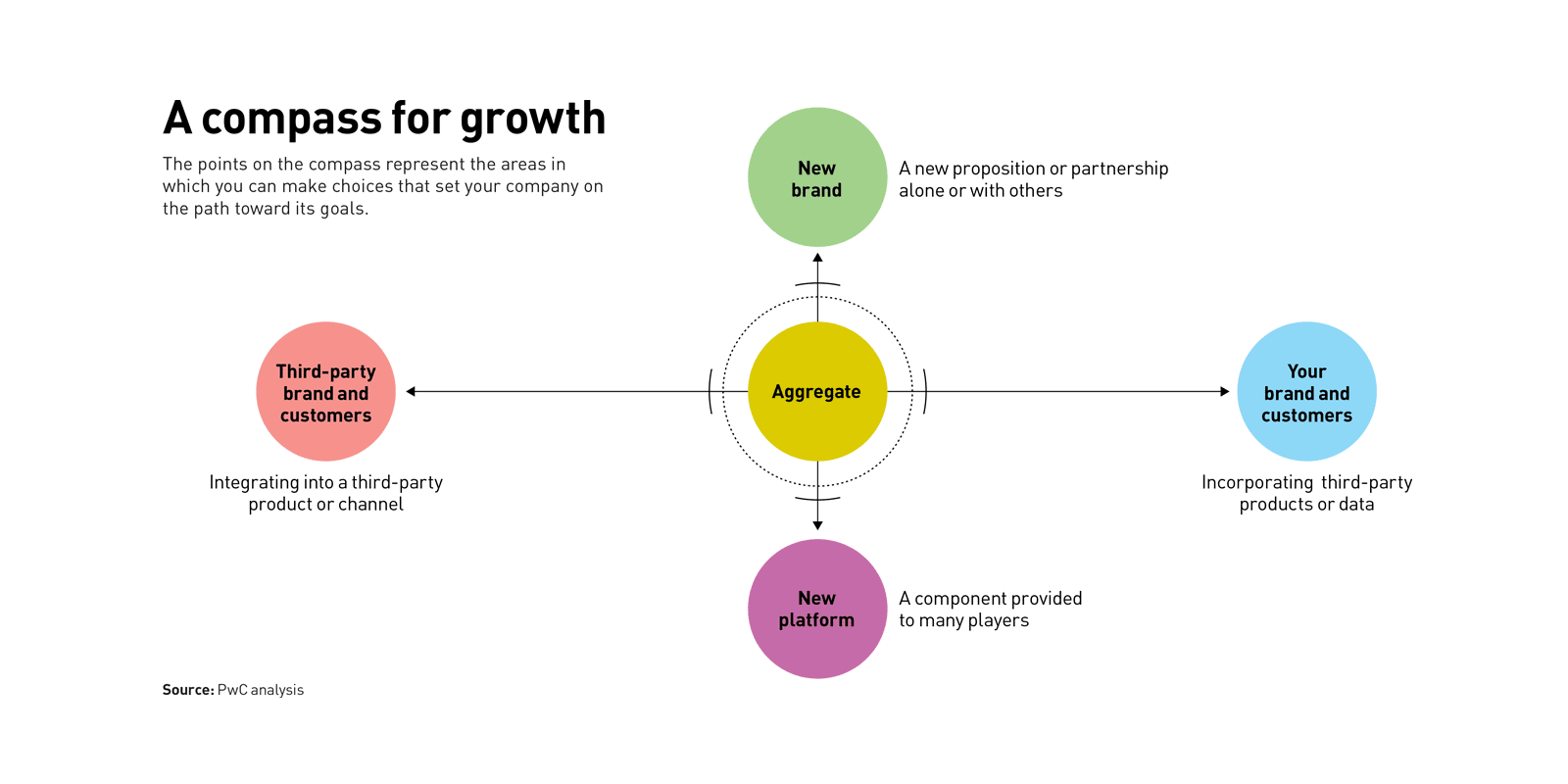Navigating your enterprise into the future
Using a compass as your guide, you can create innovative, nimble partnerships that move your company forward.
Companies worldwide are seeking their place in a time of constant change and new possibility. Wherever you are reading this, as you look into the future of your business, you’re likely striving for one or more of these goals:
- Growth
- Enhanced customer experience
- Higher profits
- Cost reductions
- Innovation
However, you may be feeling stuck as you contemplate the steps that will put you on the path toward achieving your goals. How can you transform an enormous company, one with thousands of employees that’s been in business for decades, into a nimble enterprise with a digitally savvy future? And you may have an even more urgent problem: Your company’s growth and revenue, once thriving, may now be stalling. You know you need to move into the future — but how can you be old and new at the same time?
The answer is, you can’t — at least, not all at once. It’s next to impossible to pull a giant organization, with hundreds of ingrained processes, divisions, and stakeholders, into a new digital and competitive landscape in one go. Many companies facing this challenge today invest deeply in research and development, thinking that knowledge alone will help right their course. But there’s no correlation between a company’s increased spending in research and development and a stellar performance.
It’s not surprising, then, that you feel overwhelmed. You feel you’re on the precipice of profound change, yet you simply can’t move your company in a way that will achieve your goals or realize your vision.
Let the compass guide you
The secret to overcoming these challenges lies in the humble compass. Invented in the second century BC, its principles of directional guidance can be used today to create a road map to the future, one that breaks down choices that are actionable and impactful and delivers tangible results. A compass helps you and your company consider new options and strategies — and ultimately make those first small but critical steps into the future (see “A compass for growth”).
The aim is to lift your organization to a new position while playing to its strengths, and to get momentum going in a new direction. Using the directional labeling of the compass as a guide, you can move in one of four directions.
East: Your brand and customers, incorporating third-party products. You choose to focus on keeping your customers within your existing ecosystem, and draw in external parties to fulfill their broader needs. For example, the Chinese messaging app WeChat contains the services of other companies within its branded experience, consolidating a wide range of customer needs from inside the WeChat brand, including a Google mini program, which embeds Google services into its platform.
This direction coincides with the rise of so-called super apps, whose purpose is to serve as an ecosystem that keeps customers engaged within a single platform. A super app offers a variety of apps, from messaging to social media to banking, in a single view and place, removing friction from the experience of hopping from one app to another. The ease of use begets customer loyalty and thus builds trust. Super apps are especially prevalent in Asia, where popular platforms include Alipay and Gojek.
West: Your partnerships with third-party brands and customers. As the polar opposite of the east, this direction is where your company creates new avenues through innovative partnerships or channels. These can open up access to another brand’s audience or reach entirely new audiences. For example, Chemist Warehouse is one of the largest Australia-based sellers in the Chinese market. In 2015, it entered into a relationship with Alibaba, partnering with the Chinese company’s TMall platform to distribute pharmacy products, in the process becoming one of the top sellers at Alibaba’s midyear 618 festival.
South: A new platform to offer your components to other companies. Rather than diversifying, you become very good at one thing — and you let other people use it. Intel, for instance, began its life as a chipmaker, but has become known as the supplier of processors that are built into virtually every PC on the market. Teflon coating is built into countless brands of cookware, and Gore-Tex water-resistant fabric is used in a variety of clothing lines. The newest examples of this direction are found in the use of open-source APIs and open data: Developers and companies making open-source code grow directly as a result of their products being adopted and adapted by third parties. PayPal, for example, enables others to buy and sell online through its payment gateway — it isn’t a destination unto itself.
North: Your entirely new brand. These can be either small, nimble spin-offs of a bigger brand, such as ING-backed finance app Yolt, or, more commonly, a new brand resulting from a partnership between two companies/brands. Consider TurnKey, the new brand created by Amazon and real-estate giant Realogy. A home buyer who buys a house through a Realogy agent gets thousands of dollars’ worth of Amazon products (such as Echo Dot and Echo Show) and services (such as house cleaning and furniture assembly). The new brand helps Realogy compete with lower-fee real estate companies such as Redfin, and helps Amazon Home Services compete with companies such as TaskRabbit.
Center: The aggregators. Aggregators are app stores that feature your brand, or sites that promote your brand among others in new and interesting ways. In 2018, for example, Barclays created a dashboard through its Open Banking feature that aggregates information on a customer’s entire financial landscape, even if some individual components are outside the bank itself. Quicken offers a similar type of integration, with plug-ins for tax calculators, interest rate information, and other related content and products. Comparison websites such as TripAdvisor.com, Hotels.com, and Booking.com are examples of companies profiting from aggregating services of other companies.
Pick a direction and make a move
Wherever you look, opportunities exist to make a move that will grow your company. Remember, you don’t have to reinvent the wheel — or drag your entire enterprise in a direction that it may not be able to go all at once. The idea is that you believe in something and have a vision — and if it works, you will be on your way along the path toward further growth. There should be clear, definable KPIs to show success.
The aim is to lift your organization to a new position while playing to its strengths, and to get momentum going in a new direction.
By stepping in a new direction, through a partnership and perhaps a co-branded effort, you’ll see your brand gathering new consumers and fans, which will “lift” your core brand and company.
Of course, each of these directions are interconnected, and opportunities can be created once you make your move. It’s all about a vision for creating new value — something that will grow your business, and your customer engagement. When you work with another brand that’s unlike yours, it will change your perspective, breaking barriers and that feeling of institutional paralysis, with the satisfying feeling of getting new things done in new ways. It can create a feeling of an almost chemical change in what’s possible.
And once you use the compass to help you decide which way to make a move, it will become part of your larger digital strategy — your true north. It will help you and your company keep your eye on, and move to, what comes next — organically, quickly, and strategically.






